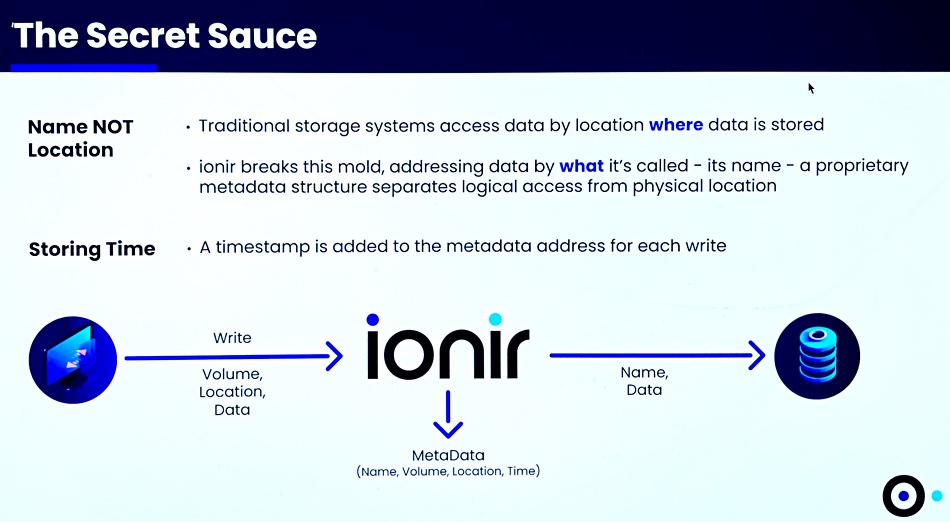Profile Last month Blocks & Files interviewed Ionir marketing head Kirby Wadsworth and CEO Jacob Cherian to find out more about this storage startup.
Ionir stores block data using a generated name and virtual, time-sensitive location mapping metadata so that it can be moved in place and in time to enable persistent volume mobility – fast mobility to any point in time – for Kubernetes applications.
Ionir software provides persistent block storage volumes to cloud-native applications using Kubernetes. It uses technology developed by Reduxio, a company that failed to progress, and the former home of many Ionir founders.
Wadsworth said Ionir’s software is “elastic and dynamic with near-infinite capacity and performance,” and quite different from traditional block storage.
The location anchor
He said that traditional block storage data is defined by its location in a storage volume and an offset from the start of the volume. The volume is a logical location mapped to physical disk or NAND storage media.
Ionir’s technology accepts an incoming data write and generates a hash value from its contents, called its Name. It also generates a timestamp so that data with that name can be accessed by time.

The data is then stored in a volume and has three basic metadata items associated with it; name, physical location (volume + offset), and time. The volume and offset are collectively called a Tag.
Now assume a second data write comes in and its generated hash has the same value as the first item. Then no new data is stored but new metadata calculated; the second item’s tag and time. This is intrinsic deduplication in the block datastore, “Any block repeating an existing one is mapped to it,” Wadworth said.

If a third item comes in and its name is different, the new data is stored together with its metadata; name, tag and time. The chart above depicts this process, with unique data items represented by green lego bricks.
This combination of features means that the Ionir block store provides continuous data protection with no need for a separate data protection application. There is also no need either for snapshots or application quiescing to enable a snapshot to be taken.
The Ionir structure can be seen as a key:value store with the name being the key, and the data being the value. The data can be arbitrarily large, according to Ionir.
We suggested it was similar to object storage in that a data item’s name (Ionir) or address (object storage) is a hash generated from its contents. Cherian was emphatic in denying this: “It is not an object storage system.”
Data Teleport>
Here we have the basics for Ionir’s DataTeleport technology. If data has to be moved back in time – to a point just before a ransomware attack, for example, the restore to a previous point in time, using the timestamps, takes about a second; meaning a 1 second RPO.
If data has to be moved to a new location the metadata is moved first and this takes up to 40 seconds – it depends upon the size of the metadata store – after which the data can be accessed from the new location as the name in the metadata store is mapped to the original location. The location maps are altered as the data itself is physically moved, using smart pre-fetch algorithms. In effect the data is cloned.
Ionir says that its Data Teleport technology makes data portable, quickly portable in fact, and available, at any location in an on-premises and public cloud ‘space’ which can include multiple on-premises locations and public clouds in a multi-hybrid cloud infrastructure.
Cloud-native technology
Ionir’s software has three components, called the Pitcher, the Catcher and the Keeper.

The pitcher is the front end and receives data read and write requests from applications and compresses/decompresses data. Metadata is managed and accessed through the Catcher software and it carries out the intrinsic deduplication. Data is actually written to storage media by the Keeper component and it uses NVMe-accessed flash storage.
These three software components are written as microservices and are Kubernetes-orchestrated containers. Other containers request storage services from the Ionir containers using Kubernetes’ CSI interface.
The Ionir software supports automated tiering.
Its route to market is via a small direct sales force and channel partners such as the service providers outside the hyperscaler segment. Wadsworth said “Kubernetes levels the playing field,” and this benefits a small startup.
Future developments
What about the future?
Cherian said: Today, we store blocks of data, put together into volumes and presented to applications.” But: “A Pitcher could be developed to have a new interface.” An actual key:value interface was mentioned as an example in passing.
Also: “A new Keeper could be developed to support objects and different storage media. … We could have an S3 front end or backend. We’re storage protocol and access agnostic.”








